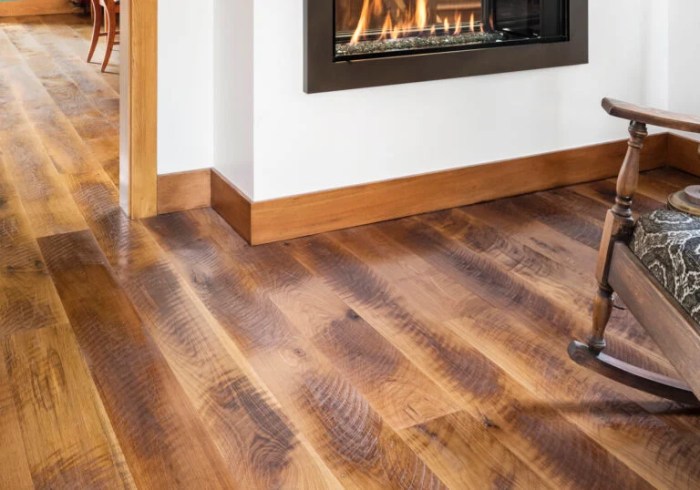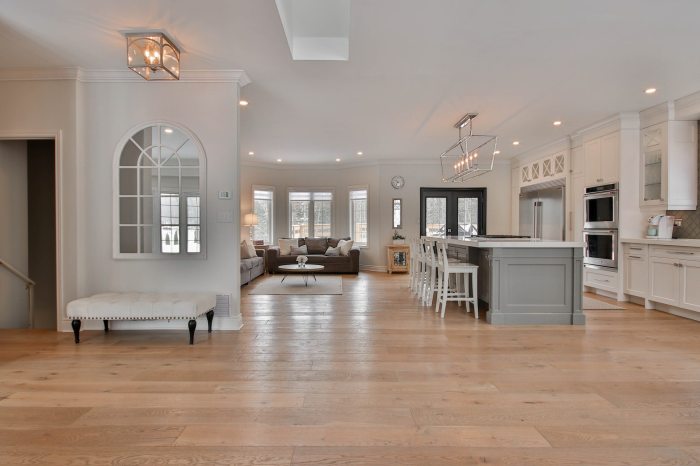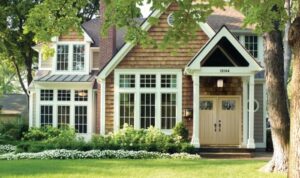Embark on a journey to discover the perfect flooring options for your home remodel. From durability to aesthetic appeal, we delve into everything you need to know to make the right choice.
Types of Flooring Options

When it comes to selecting flooring for your home remodel, there are various options to choose from. Each type of flooring material has its own unique characteristics, durability, maintenance requirements, aesthetic appeal, and cost-effectiveness.
Hardwood Flooring
- Hardwood flooring is known for its timeless beauty and durability.
- It requires regular maintenance such as refinishing and polishing to keep it looking its best.
- Hardwood flooring adds a warm and elegant feel to any room but can be more expensive than other options.
Laminate Flooring
- Laminate flooring is a cost-effective alternative to hardwood, offering a similar look at a lower price.
- It is easy to clean and maintain, making it a popular choice for busy households.
- Laminate flooring is not as durable as hardwood and may need to be replaced sooner.
Tile Flooring
- Tile flooring is highly durable and water-resistant, making it ideal for kitchens, bathrooms, and high-traffic areas.
- It comes in a variety of styles, colors, and patterns, allowing for endless design possibilities.
- Tile flooring can be cold and hard underfoot, requiring area rugs for added comfort.
Carpet Flooring
- Carpet flooring is soft, comfortable, and provides insulation, making it a cozy option for bedrooms and living rooms.
- It requires regular vacuuming and professional cleaning to maintain its appearance.
- Carpet flooring can trap allergens and may need to be replaced more frequently than other options.
Vinyl Flooring
- Vinyl flooring is affordable, versatile, and easy to install, making it a popular choice for DIY projects.
- It is durable, water-resistant, and low maintenance, suitable for high-traffic areas in the home.
- Vinyl flooring comes in a wide range of designs, including styles that mimic hardwood and tile.
Factors to Consider
When choosing the best flooring for your home remodel, it is essential to consider various factors to ensure you make the right choice. Factors such as room usage, lifestyle, and overall design play a significant role in selecting the most suitable flooring option.
Room Usage
- For high-traffic areas such as the kitchen and living room, durable flooring options like hardwood, laminate, or tile are ideal to withstand heavy use.
- In bedrooms, carpet or hardwood flooring can provide comfort and warmth, creating a cozy atmosphere.
- Bathrooms require moisture-resistant flooring like vinyl or tile to prevent water damage.
Lifestyle Factors
- If you have pets, consider scratch-resistant flooring like luxury vinyl or tile to withstand their claws.
- For households with children, opt for easy-to-clean flooring like laminate or vinyl to handle spills and messes.
- If allergies are a concern, choose flooring that does not harbor dust or allergens, such as hardwood or tile.
Complementing Home Design
- Consider the overall design and style of your home when selecting flooring to ensure a cohesive look throughout.
- Choose flooring that complements the color scheme and aesthetic of your home, whether it's modern, traditional, or eclectic.
- Take into account factors like natural light, furniture, and decor when deciding on the flooring material and color.
Installation Process
When it comes to installing different types of flooring, the process can vary depending on the material you choose. It is essential to follow the specific guidelines provided by the manufacturer to ensure a successful installation. Here, we will discuss the general steps involved in installing various types of flooring, the tools and materials needed for a DIY installation, as well as the importance of subfloor preparation and underlayment for different flooring materials.
General Steps for Flooring Installation
- 1. Prepare the subfloor: Ensure that the subfloor is clean, dry, and level before proceeding with the installation.
- 2. Acclimate the flooring material: Allow the flooring material to acclimate to the room's temperature and humidity for a specified period.
- 3. Measure and plan: Measure the room accurately and plan the layout of the flooring to minimize waste.
- 4. Install underlayment: Depending on the type of flooring, you may need to install underlayment to provide cushioning, moisture protection, or sound insulation.
- 5. Start laying the flooring: Begin installing the flooring from one corner of the room, following the manufacturer's instructions for the specific type of flooring.
- 6. Cut and fit the flooring: Use appropriate tools to cut and fit the flooring around obstacles like door frames or corners.
- 7. Finish the edges: Install any necessary trim or molding to finish the edges of the flooring and give it a polished look.
Tools and Materials for DIY Installation
- Tools: Common tools needed for DIY flooring installation include a tape measure, utility knife, hammer, pry bar, flooring nailer or stapler, and a saw appropriate for cutting the flooring material.
- Materials: The materials required will depend on the type of flooring chosen but may include the flooring material itself, underlayment, adhesive, nails or staples, and trim pieces.
Importance of Subfloor Preparation and Underlayment
Proper subfloor preparation is crucial for a successful flooring installation. A clean, level subfloor ensures that the flooring material will lay flat and securely. Underlayment also plays a vital role in providing cushioning, sound insulation, and moisture protection, depending on the type of flooring being installed.
Maintenance and Care

Proper maintenance and care are essential to keep your flooring looking great for years to come. Different types of flooring require different cleaning routines and protective measures to ensure longevity.
Hardwood Flooring
- Regularly sweep or vacuum to remove dirt and debris that can scratch the surface.
- Use a damp mop with a hardwood floor cleaner to clean the floors, avoiding excessive water.
- Avoid walking on hardwood floors with high heels or sports cleats to prevent dents and scratches.
- Consider using area rugs and furniture pads to protect the floors from wear and tear.
- Hardwood flooring typically comes with a warranty ranging from 15 to 30 years, depending on the manufacturer.
Carpet Flooring
- Vacuum regularly to prevent dirt and dust from settling deep into the fibers.
- Spot clean spills immediately with a carpet cleaner or a mixture of water and vinegar.
- Professional steam cleaning is recommended every 12-18 months to maintain the carpet's appearance.
- Use doormats at entrances and high-traffic areas to reduce the amount of dirt tracked onto the carpet.
- Most carpet warranties cover against manufacturing defects and premature wear for 5-25 years.
Tile Flooring
- Sweep or vacuum regularly to remove dirt and debris from the grout lines and tile surface.
- Mop with a tile cleaner or a mixture of water and mild detergent to keep the tiles clean and shiny.
- Use a sealant on grout lines to prevent staining and discoloration over time.
- Avoid using harsh chemicals or abrasive cleaners that can damage the tile surface.
- Tile flooring often comes with a warranty of 10-25 years, depending on the type of tile and manufacturer.
Final Summary

As we conclude this guide, remember that the right flooring can transform your space. Make sure to consider all factors and choose wisely for a beautiful and functional home.
FAQ Explained
What flooring type is best for high-traffic areas?
Hardwood or tile flooring is best for high-traffic areas due to their durability.
Can laminate flooring be installed in bathrooms?
Laminate flooring is not recommended for bathrooms due to moisture issues.
How can I protect hardwood flooring from scratches?
Use furniture pads, area rugs, and avoid wearing shoes indoors to protect hardwood flooring.
Is underlayment necessary for vinyl flooring?
Underlayment is recommended for vinyl flooring to provide cushioning and support.
What is the average lifespan of carpet flooring?
Carpet flooring typically lasts around 5-15 years, depending on quality and maintenance.






